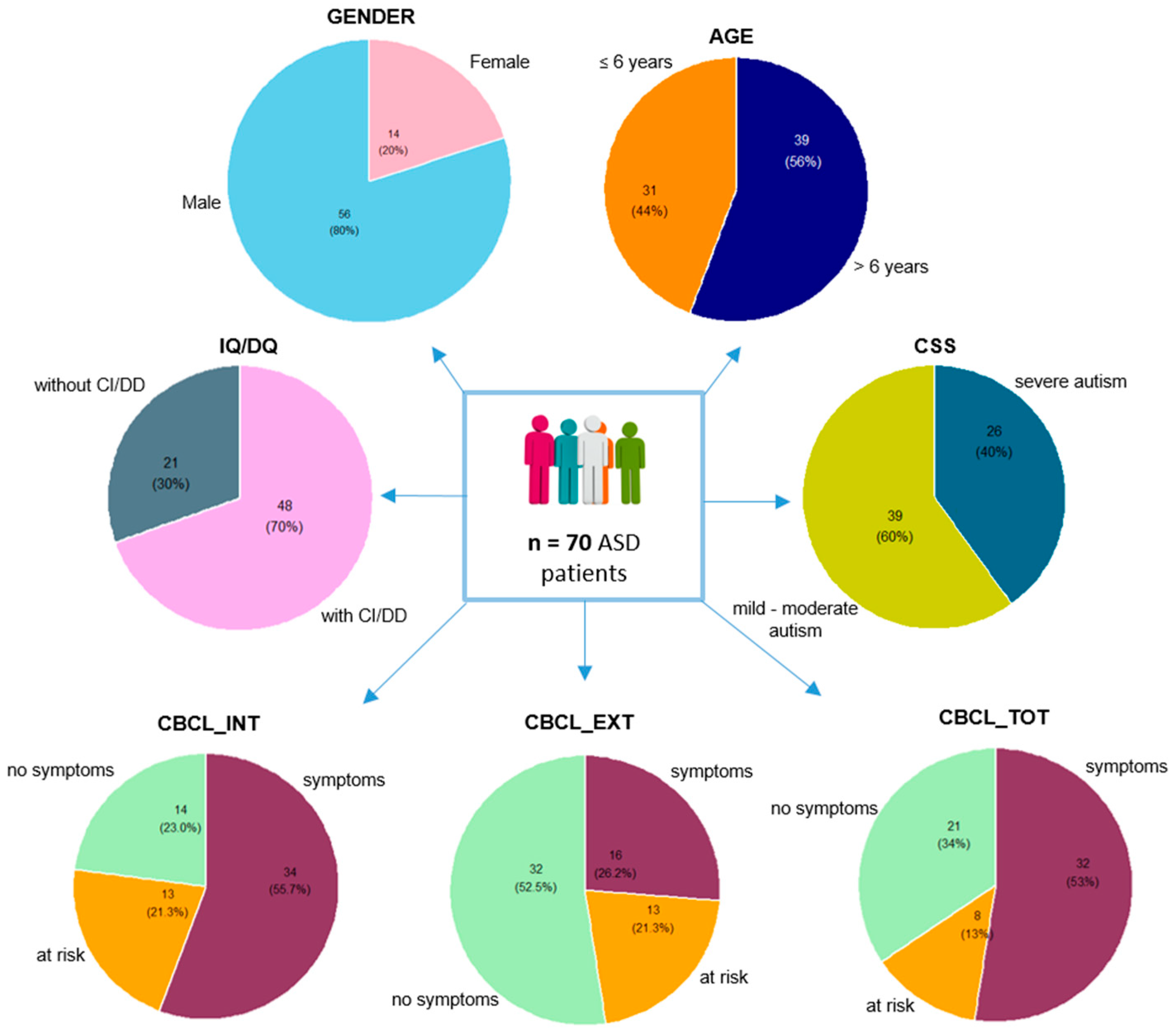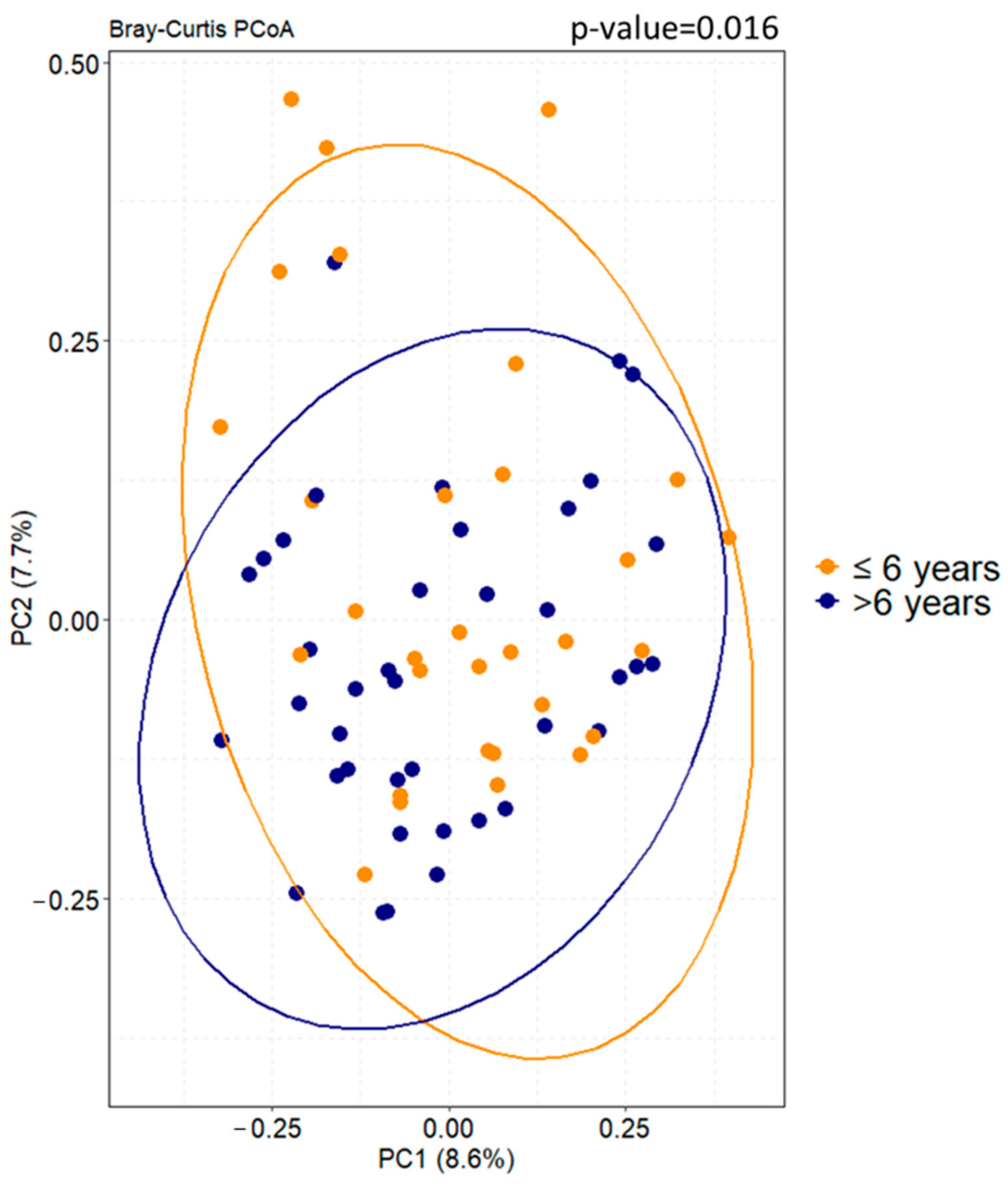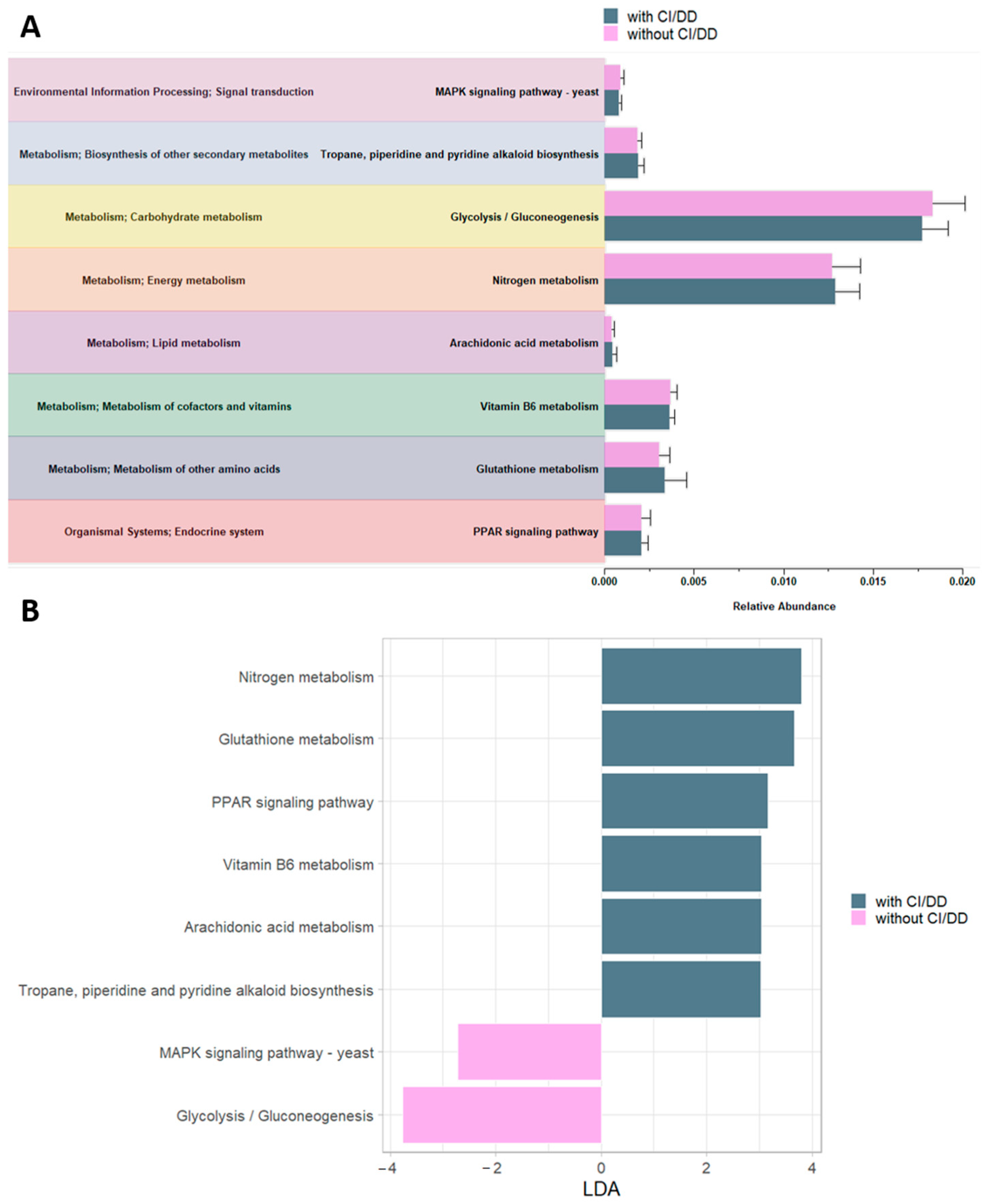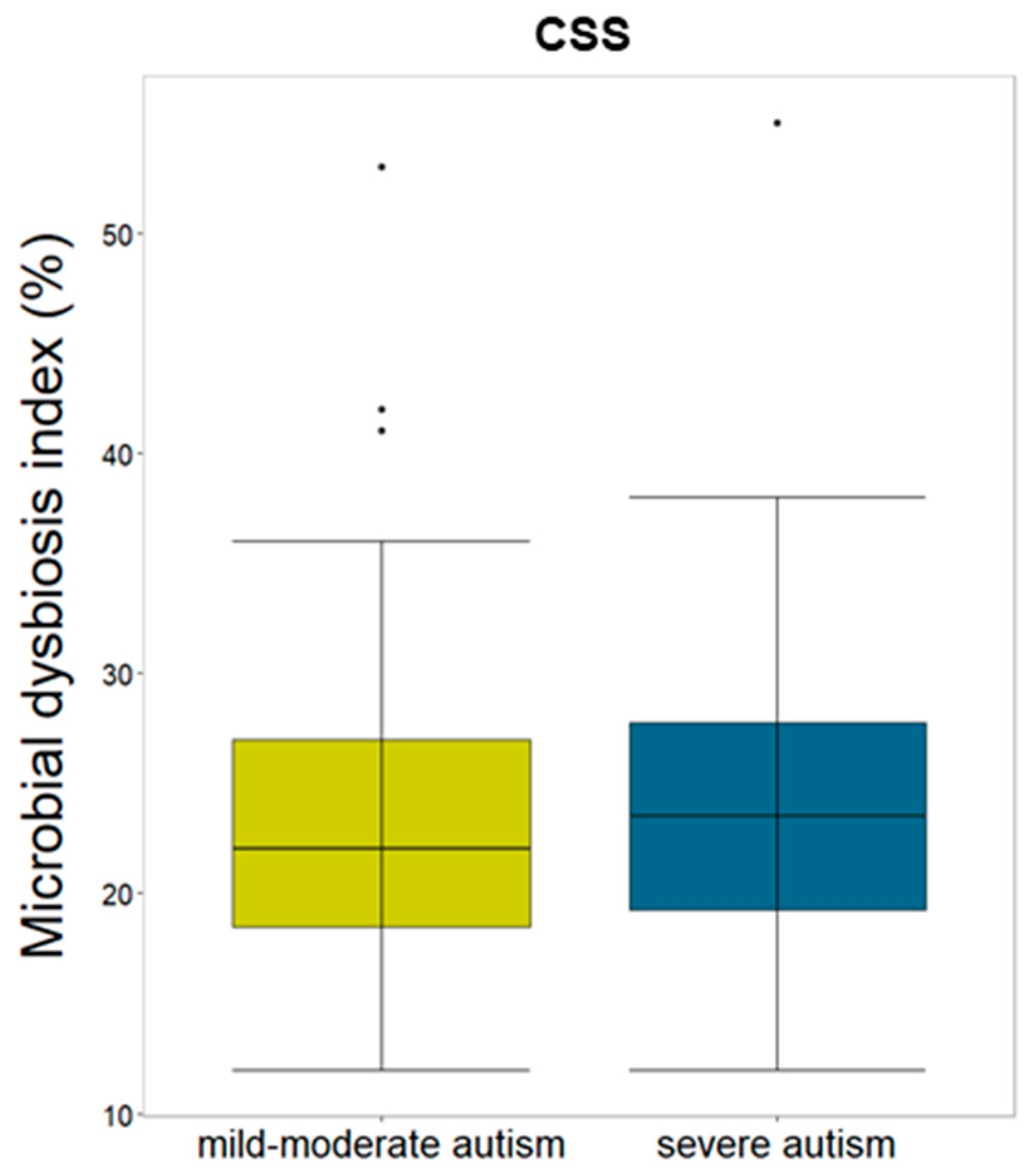Stratification of Gut Microbiota Profiling Based on Autism Neuropsychological Assessments
Abstract
:1. Introduction
2. Materials and Methods
2.1. Patient Characteristics and Sample Collection
2.2. Clinical and Neuropsychological Assessment
2.3. Ethics Statement
2.4. GM Metataxonomy Profile: Wet and Dry Analyses
2.5. Microbial Dysbiosis Index (MDI) Calculation
2.6. Statistical Analysis
3. Results
3.1. Participants Characteristics and Neuropsychological Features
3.2. Metataxonomic GM Profile
3.3. Characterization of Participants’ GM Profiles in Relation to Neuropsychological Features
3.4. Functional Prediction of GM by PICRUSt
3.5. Correlation between MDI and Neuropsychological Data
4. Discussion
5. Conclusions
Supplementary Materials
Author Contributions
Funding
Data Availability Statement
Acknowledgments
Conflicts of Interest
Abbreviations
| ASD | Autism spectrum disorder |
| GM | Gut microbiota |
| CSS | Calibrated Severity Score |
| CBCL | Child Behavior Checklist |
| INT | Internalizing |
| EXT | Externalizing |
| TOT | Total |
| IQ/DQ | Intelligent quotient/developmental quotient |
| CI/DD | Cognitive impairment/developmental delay |
| MDI | Microbial dysbiosis index |
| GI | Gastrointestinal |
| CNS | Central nervous systems |
| DSM | Diagnostic and Statistical Manual |
| ADOS | Autism Diagnostic Observation Schedule |
| ADI-R | Autism Diagnostic Interview-Revised |
| ADHD | Attention-deficit/hyperactivity disorder |
| WISC | Wechsler Intelligence Scale for Children |
| QC | Quality Check |
| ASVs | Amplicon Sequence Variants |
| CTRLs | Controls |
| PERMANOVA | Permutational multivariate analysis of variance |
| PCoA | Principal coordinate analyses |
| LEfSe | Linear Discriminant Analysis Effect size |
| LDA | Linear discriminant analysis |
| NDD | Neurodevelopmental disorders |
| AAAs | Aromatic amino acids |
| CYPs | Cytochrome P450s |
| VLDL | Very-low-density lipoprotein |
References
- American Psychiatric Association. Diagnostic and Statistical Manual of Mental Disorders, 5th ed.; American Psychiatric Association: Washington, DC, USA, 2013; ISBN 978-0-89042-555-8. [Google Scholar]
- Kacimi, F.E.; Ed-day, S.; Didou, L.; Azzaoui, F.Z.; Ramchoun, M.; Arfaoui, A.; Boulbaroud, S. Narrative Review: The Effect of Vitamin A Deficiency on Gut Microbiota and Their Link with Autism Spectrum Disorder. J. Diet. Suppl. 2024, 21, 116–134. [Google Scholar] [CrossRef] [PubMed]
- Zhu, D.; Jin, X.; Guo, P.; Sun, Y.; Zhou, L.; Qing, Y.; Shen, W.; Ji, G. Efficacy of Faecal Microbiota Transplantation for the Treatment of Autism in Children: Meta-Analysis of Randomised Controlled Trials. Evid.-Based Complement. Altern. Med. 2023, 2023, 5993628. [Google Scholar] [CrossRef] [PubMed]
- Leader, G.; Abberton, C.; Cunningham, S.; Gilmartin, K.; Grudzien, M.; Higgins, E.; Joshi, L.; Whelan, S.; Mannion, A. Gastrointestinal Symptoms in Autism Spectrum Disorder: A Systematic Review. Nutrients 2022, 14, 1471. [Google Scholar] [CrossRef] [PubMed]
- Zuffa, S.; Schimmel, P.; Gonzalez-Santana, A.; Belzer, C.; Knol, J.; Bölte, S.; Falck-Ytter, T.; Forssberg, H.; Swann, J.; Diaz Heijtz, R. Early-Life Differences in the Gut Microbiota Composition and Functionality of Infants at Elevated Likelihood of Developing Autism Spectrum Disorder. Transl. Psychiatry 2023, 13, 257. [Google Scholar] [CrossRef] [PubMed]
- Vernocchi, P.; Ristori, M.V.; Guerrera, S.; Guarrasi, V.; Conte, F.; Russo, A.; Lupi, E.; Albitar-Nehme, S.; Gardini, S.; Paci, P.; et al. Gut Microbiota Ecology and Inferred Functions in Children with ASD Compared to Neurotypical Subjects. Front. Microbiol. 2022, 13, 871086. [Google Scholar] [CrossRef] [PubMed]
- Ullah, H.; Arbab, S.; Tian, Y.; Liu, C.; Chen, Y.; Qijie, L.; Khan, M.I.U.; Hassan, I.U.; Li, K. The Gut Microbiota–Brain Axis in Neurological Disorder. Front. Neurosci. 2023, 17, 1225875. [Google Scholar] [CrossRef]
- Wan, Y.; Zuo, T.; Xu, Z.; Zhang, F.; Zhan, H.; Chan, D.; Leung, T.-F.; Yeoh, Y.K.; Chan, F.K.L.; Chan, R.; et al. Underdevelopment of the Gut Microbiota and Bacteria Species as Non-Invasive Markers of Prediction in Children with Autism Spectrum Disorder. Gut 2022, 71, 910–918. [Google Scholar] [CrossRef]
- Zheng, D.; Liwinski, T.; Elinav, E. Interaction between Microbiota and Immunity in Health and Disease. Cell Res. 2020, 30, 492–506. [Google Scholar] [CrossRef]
- Putignani, L.; Del Chierico, F.; Vernocchi, P.; Cicala, M.; Cucchiara, S.; Dallapiccola, B. Gut Microbiota Dysbiosis as Risk and Premorbid Factors of IBD and IBS Along the Childhood–Adulthood Transition. Inflamm. Bowel Dis. 2016, 22, 487–504. [Google Scholar] [CrossRef]
- Nagpal, J.; Cryan, J.F. Microbiota-Brain Interactions: Moving toward Mechanisms in Model Organisms. Neuron 2021, 109, 3930–3953. [Google Scholar] [CrossRef]
- Carding, S.; Verbeke, K.; Vipond, D.T.; Corfe, B.M.; Owen, L.J. Dysbiosis of the Gut Microbiota in Disease. Microb. Ecol. Health Dis. 2015, 26, 26191. [Google Scholar] [CrossRef] [PubMed]
- Pompili, E.; Biondi, M.; Nicolò, G. (Eds.) DSM-5-TR: Manuale Diagnostico e Statistico dei Disturbi Mentali, 5th ed; Raffaello Cortina: Milano, Italy, 2023; ISBN 978-88-328-5516-6. [Google Scholar]
- Lord, C.; Rutter, M. Autism Diagnostic Observation Schedule, Second Edition (ADOS-2) Manual (Part I): Modules 1–4, 2nd ed.; Western Psychological Services: Torrance, CA, USA, 2012. [Google Scholar]
- Guerrera, S.; Menghini, D.; Napoli, E.; Di Vara, S.; Valeri, G.; Vicari, S. Assessment of Psychopathological Comorbidities in Children and Adolescents with Autism Spectrum Disorder Using the Child Behavior Checklist. Front. Psychiatry 2019, 10, 535. [Google Scholar] [CrossRef] [PubMed]
- Shumway, S.; Farmer, C.; Thurm, A.; Joseph, L.; Black, D.; Golden, C. The ADOS Calibrated Severity Score: Relationship to Phenotypic Variables and Stability over Time. Autism Res. 2012, 5, 267–276. [Google Scholar] [CrossRef] [PubMed]
- Esler, A.N.; Bal, V.H.; Guthrie, W.; Wetherby, A.; Weismer, S.E.; Lord, C. The Autism Diagnostic Observation Schedule, Toddler Module: Standardized Severity Scores. J. Autism. Dev. Disord. 2015, 45, 2704–2720. [Google Scholar] [CrossRef] [PubMed]
- Hus, V.; Lord, C. The Autism Diagnostic Observation Schedule, Module 4: Revised Algorithm and Standardized Severity Scores. J. Autism. Dev. Disord. 2014, 44, 1996–2012. [Google Scholar] [CrossRef]
- Gotham, K.; Pickles, A.; Lord, C. Standardizing ADOS Scores for a Measure of Severity in Autism Spectrum Disorders. J. Autism. Dev. Disord. 2009, 39, 693–705. [Google Scholar] [CrossRef]
- Waizbard-Bartov, E.; Fein, D.; Lord, C.; Amaral, D.G. Autism Severity and Its Relationship to Disability. Autism Res. 2023, 16, 685–696. [Google Scholar] [CrossRef]
- Lord, C.; Rutter, M.; Le Couteur, A. Autism Diagnostic Interview-Revised: A Revised Version of a Diagnostic Interview for Caregivers of Individuals with Possible Pervasive Developmental Disorders. J. Autism. Dev. Disord. 1994, 24, 659–685. [Google Scholar] [CrossRef]
- Andreoli, V.; Cassano, G.B.; Rossi, R. DSM-IV-TR: Manuale Diagnostico e Statistico Dei Disturbi Mentali, 4th ed.; Masson: Milano, Italy, 2002; ISBN 978-88-214-2588-2. [Google Scholar]
- Achenbach, T.M.; Rescorla, L. Manual for the ASEBA Preschool Forms & Profiles; ASEBA: Burlington, VT, USA, 2000. [Google Scholar]
- Achenbach, T.M.; Rescorla, L. Manual for the ASEBA School-Age Forms & Profiles: An Integrated System of Multi-Informant Assessment; ASEBA: Burlington, VT, USA, 2001; ISBN 978-0-938565-73-4. [Google Scholar]
- Wechsler, D. WISC-IV Wechsler Intelligence Scale for Children—Quarta Edizione Manuale di Somministrazione e Scoring; Orsini, A., Pezzuti, L., Eds.; Giunti Psychometrics: Firenze, Italy, 2019; ISBN 978-88-09-76995-3. [Google Scholar]
- Roid, G.H.; Miller, L.J.; Pomplun, M.; Koch, C. Leiter International Performance Scale, 3rd ed.; Leiter-3: Wood Dale, IL, USA, 2013. [Google Scholar]
- Green, E.; Stroud, L.; Bloomfield, S. Griffith III: Griffiths Scales of Child Development, 3rd ed.; Hogrefe: Oxford, UK, 2016. [Google Scholar]
- Bolyen, E.; Rideout, J.R.; Dillon, M.R.; Bokulich, N.A.; Abnet, C.C.; Al-Ghalith, G.A.; Alexander, H.; Alm, E.J.; Arumugam, M.; Asnicar, F.; et al. Reproducible, Interactive, Scalable and Extensible Microbiome Data Science Using QIIME 2. Nat. Biotechnol. 2019, 37, 852–857. [Google Scholar] [CrossRef]
- Callahan, B.J.; McMurdie, P.J.; Rosen, M.J.; Han, A.W.; Johnson, A.J.A.; Holmes, S.P. DADA2: High-Resolution Sample Inference from Illumina Amplicon Data. Nat. Methods 2016, 13, 581–583. [Google Scholar] [CrossRef]
- Janssen, S.; McDonald, D.; Gonzalez, A.; Navas-Molina, J.A.; Jiang, L.; Xu, Z.Z.; Winker, K.; Kado, D.M.; Orwoll, E.; Manary, M.; et al. Phylogenetic Placement of Exact Amplicon Sequences Improves Associations with Clinical Information. mSystems 2018, 3, e00021-18. [Google Scholar] [CrossRef] [PubMed]
- Leti, G. Statistica Descrittiva; il Mulino: Bologna, Italy, 2001; ISBN 978-88-15-00278-5. [Google Scholar]
- Toto, F.; Marangelo, C.; Scanu, M.; De Angelis, P.; Isoldi, S.; Abreu, M.T.; Cucchiara, S.; Stronati, L.; Del Chierico, F.; Putignani, L. A Novel Microbial Dysbiosis Index and Intestinal Microbiota-Associated Markers as Tools of Precision Medicine in Inflammatory Bowel Disease Paediatric Patients. Int. J. Mol. Sci. 2024, 25, 9618. [Google Scholar] [CrossRef] [PubMed]
- Paulson, J.N.; Stine, O.C.; Bravo, H.C.; Pop, M. Differential Abundance Analysis for Microbial Marker-Gene Surveys. Nat. Methods 2013, 10, 1200–1202. [Google Scholar] [CrossRef] [PubMed]
- Segata, N.; Izard, J.; Waldron, L.; Gevers, D.; Miropolsky, L.; Garrett, W.S.; Huttenhower, C. Metagenomic Biomarker Discovery and Explanation. Genome Biol. 2011, 12, R60. [Google Scholar] [CrossRef] [PubMed]
- Kanehisa, M.; Goto, S.; Sato, Y.; Furumichi, M.; Tanabe, M. KEGG for Integration and Interpretation of Large-Scale Molecular Data Sets. Nucleic Acids Res. 2012, 40, D109–D114. [Google Scholar] [CrossRef]
- Douglas, S.; Berthod, O.; Groenleer, M.; Nederhand, J. Pathways to Collaborative Performance: Examining the Different Combinations of Conditions under Which Collaborations Are Successful. Policy Soc. 2020, 39, 638–658. [Google Scholar] [CrossRef]
- Yang, C.; Mai, J.; Cao, X.; Burberry, A.; Cominelli, F.; Zhang, L. Ggpicrust2: An R Package for PICRUSt2 Predicted Functional Profile Analysis and Visualization. Bioinformatics 2023, 39, btad470. [Google Scholar] [CrossRef]
- Phan, J.; Calvo, D.C.; Nair, D.; Jain, S.; Montagne, T.; Dietsche, S.; Blanchard, K.; Treadwell, S.; Adams, J.; Krajmalnik-Brown, R. Precision Synbiotics Increase Gut Microbiome Diversity and Improve Gastrointestinal Symptoms in a Pilot Open-Label Study for Autism Spectrum Disorder. mSystems 2024, 9, e00503-24. [Google Scholar] [CrossRef]
- Li, H.; Guo, W.; Li, S.; Sun, B.; Li, N.; Xie, D.; Dong, Z.; Luo, D.; Chen, W.; Fu, W.; et al. Alteration of the Gut Microbiota Profile in Children with Autism Spectrum Disorder in China. Front. Microbiol. 2024, 14, 1326870. [Google Scholar] [CrossRef]
- Lou, M.; Cao, A.; Jin, C.; Mi, K.; Xiong, X.; Zeng, Z.; Pan, X.; Qie, J.; Qiu, S.; Niu, Y.; et al. Deviated and Early Unsustainable Stunted Development of Gut Microbiota in Children with Autism Spectrum Disorder. Gut 2021, 71, 325115. [Google Scholar] [CrossRef]
- Kim, C.C.; Healey, G.R.; Kelly, W.J.; Patchett, M.L.; Jordens, Z.; Tannock, G.W.; Sims, I.M.; Bell, T.J.; Hedderley, D.; Henrissat, B.; et al. Genomic Insights from Monoglobus pectinilyticus: A Pectin-Degrading Specialist Bacterium in the Human Colon. ISME J. 2019, 13, 1437–1456. [Google Scholar] [CrossRef] [PubMed]
- Efimov, B.A.; Chaplin, A.V.; Sokolova, S.R.; Chernaia, Z.A.; Pikina, A.P.; Savilova, A.M.; Kafarskaya, L.I. Application of Culture-Based, Mass Spectrometry and Molecular Methods to the Study of Gut Microbiota in Children. BRSMU 2019, 4, 54–65. [Google Scholar] [CrossRef]
- Taniya, M.A.; Chung, H.-J.; Al Mamun, A.; Alam, S.; Aziz, M.A.; Emon, N.U.; Islam, M.M.; Hong, S.-T.S.; Podder, B.R.; Ara Mimi, A.; et al. Role of Gut Microbiome in Autism Spectrum Disorder and Its Therapeutic Regulation. Front. Cell. Infect. Microbiol. 2022, 12, 915701. [Google Scholar] [CrossRef] [PubMed]
- Bojović, K.; Ignjatović, Ð.-D.I.; Soković Bajić, S.; Vojnović Milutinović, D.; Tomić, M.; Golić, N.; Tolinački, M. Gut Microbiota Dysbiosis Associated with Altered Production of Short Chain Fatty Acids in Children with Neurodevelopmental Disorders. Front. Cell. Infect. Microbiol. 2020, 10, 223. [Google Scholar] [CrossRef] [PubMed]
- Steckler, R.; Magzal, F.; Kokot, M.; Walkowiak, J.; Tamir, S. Disrupted Gut Harmony in Attention-Deficit/Hyperactivity Disorder: Dysbiosis and Decreased Short-Chain Fatty Acids. Brain Behav. Immun.—Health 2024, 40, 100829. [Google Scholar] [CrossRef] [PubMed]
- Cheung, S.G.; Goldenthal, A.R.; Uhlemann, A.-C.; Mann, J.J.; Miller, J.M.; Sublette, M.E. Systematic Review of Gut Microbiota and Major Depression. Front. Psychiatry 2019, 10, 34. [Google Scholar] [CrossRef] [PubMed]
- Chamtouri, M.; Gaddour, N.; Merghni, A.; Mastouri, M.; Arboleya, S.; De Los Reyes-Gavilán, C.G. Age and Severity-Dependent Gut Microbiota Alterations in Tunisian Children with Autism Spectrum Disorder. Sci. Rep. 2023, 13, 18218. [Google Scholar] [CrossRef]
- Luna, R.A.; Oezguen, N.; Balderas, M.; Venkatachalam, A.; Runge, J.K.; Versalovic, J.; Veenstra-VanderWeele, J.; Anderson, G.M.; Savidge, T.; Williams, K.C. Distinct Microbiome-Neuroimmune Signatures Correlate with Functional Abdominal Pain in Children with Autism Spectrum Disorder. Cell. Mol. Gastroenterol. Hepatol. 2017, 3, 218–230. [Google Scholar] [CrossRef]
- Ashwood, P.; Krakowiak, P.; Hertz-Picciotto, I.; Hansen, R.; Pessah, I.N.; Van De Water, J. Associations of Impaired Behaviors with Elevated Plasma Chemokines in Autism Spectrum Disorders. J. Neuroimmunol. 2011, 232, 196–199. [Google Scholar] [CrossRef]
- Ashwood, P.; Krakowiak, P.; Hertz-Picciotto, I.; Hansen, R.; Pessah, I.; Van De Water, J. Elevated Plasma Cytokines in Autism Spectrum Disorders Provide Evidence of Immune Dysfunction and Are Associated with Impaired Behavioral Outcome. Brain Behav. Immun. 2011, 25, 40–45. [Google Scholar] [CrossRef]
- Dan, Z.; Mao, X.; Liu, Q.; Guo, M.; Zhuang, Y.; Liu, Z.; Chen, K.; Chen, J.; Xu, R.; Tang, J.; et al. Altered Gut Microbial Profile Is Associated with Abnormal Metabolism Activity of Autism Spectrum Disorder. Gut Microbes 2020, 11, 1246–1267. [Google Scholar] [CrossRef] [PubMed]
- Notting, F.; Pirovano, W.; Sybesma, W.; Kort, R. The Butyrate-Producing and Spore-Forming Bacterial Genus Coprococcus as a Potential Biomarker for Neurological Disorders. Gut. Microb. 2023, 4, e16. [Google Scholar] [CrossRef] [PubMed]
- Bessis, S.; Amadou, T.; Dubourg, G.; Raoult, D.; Fournier, P.-E. “Bariatricus Massiliensis” as a New Bacterial Species from Human Gut Microbiota. New Microbes New Infect. 2016, 12, 54–55. [Google Scholar] [CrossRef] [PubMed]
- De Angelis, P.M.; Dorg, L.; Pham, S.; Andersen, S.N. DNA Repair Protein Expression and Oxidative/Nitrosative Stress in Ulcerative Colitis and Sporadic Colorectal Cancer. Anticancer. Res. 2021, 41, 3261–3270. [Google Scholar] [CrossRef] [PubMed]
- Raghuram, G.V.; Chaudhary, S.; Johari, S.; Mittra, I. Illegitimate and Repeated Genomic Integration of Cell-Free Chromatin in the Aetiology of Somatic Mosaicism, Ageing, Chronic Diseases and Cancer. Genes 2019, 10, 407. [Google Scholar] [CrossRef]
- Chen, L.; Chang, S.; Chang, H.; Wu, C.; Pan, C.; Chang, C.; Chan, C.; Huang, H. Probiotic Supplementation Attenuates Age—related Sarcopenia via the Gut–Muscle Axis in SAMP8 Mice. J Cachexia Sarcopenia Muscle 2022, 13, 515–531. [Google Scholar] [CrossRef]
- Fang, X.; Yu, L.; Wang, D.; Chen, Y.; Wang, Y.; Wu, Z.; Liu, R.; Ren, J.; Tang, W.; Zhang, C. Association Between SIRT1, Cytokines, and Metabolic Syndrome in Schizophrenia Patients with Olanzapine or Clozapine Monotherapy. Front. Psychiatry 2020, 11, 602121. [Google Scholar] [CrossRef]
- Chew, S.Y.; Than, L.T.L. Glucose Metabolism and Use of Alternative Carbon Sources in Medically-Important Fungi. In Encyclopedia of Mycology; Elsevier: Amsterdam, The Netherlands, 2021; pp. 220–229. ISBN 978-0-323-85180-0. [Google Scholar]
- Zaragoza, Ó.; Casadevall, A. (Eds.) Encyclopedia of Mycology; Elsevier: Amsterdam, The Netherlands, 2021; ISBN 978-0-323-85180-0. [Google Scholar]
- Popescu, S.C.; Tomaso-Peterson, M.; Wilkerson, T.; Bronzato-Badial, A.; Wesser, U.; Popescu, G.V. Metagenomic Analyses of the Soybean Root Mycobiome and Microbiome Reveal Signatures of the Healthy and Diseased Plants Affected by Taproot Decline. Microorganisms 2022, 10, 856. [Google Scholar] [CrossRef]
- Zhou, Y.; Tang, J.; Du, W.; Zhang, Y.; Ye, B.-C. Screening Potential Biomarkers Associated with Insulin Resistance in High-Fat Diet-Fed Mice by Integrating Metagenomics and Untargeted Metabolomics. Microbiol. Spectr. 2024, 12, e04094-23. [Google Scholar] [CrossRef]
- Chao, Y.T.; Lin, Y.-K.; Chen, L.-K.; Huang, P.; Hsu, Y.-C. Role of the Gut Microbiota and Their Metabolites in Hemodialysis Patients. Int. J. Med. Sci. 2023, 20, 725–736. [Google Scholar] [CrossRef]
- Colhoun, H.M.; Otvos, J.D.; Rubens, M.B.; Taskinen, M.R.; Underwood, S.R.; Fuller, J.H. Lipoprotein Subclasses and Particle Sizes and Their Relationship with Coronary Artery Calcification in Men and Women with and Without Type 1 Diabetes. Diabetes 2002, 51, 1949–1956. [Google Scholar] [CrossRef] [PubMed]
- Li, X.; Chen, Y.; Peng, X.; Zhu, Y.; Duan, W.; Ji, R.; Xiao, H.; Li, X.; Liu, G.; Yu, Y.; et al. Anti-Inflammation Mechanisms of a Homogeneous Polysaccharide from Phyllanthus Emblica L. on DSS Induced Colitis Mice via the Gut Microbiota and Metabolites Alteration. Food Chem. 2024, 459, 140346. [Google Scholar] [CrossRef]
- Gil-Cardoso, K.; Ginés, I.; Pinent, M.; Ardévol, A.; Blay, M.; Terra, X. Effects of Flavonoids on Intestinal Inflammation, Barrier Integrity and Changes in Gut Microbiota during Diet-Induced Obesity. Nutr. Res. Rev. 2016, 29, 234–248. [Google Scholar] [CrossRef] [PubMed]
- Schoeler, M.; Caesar, R. Dietary Lipids, Gut Microbiota and Lipid Metabolism. Rev. Endocr. Metab. Disord. 2019, 20, 461–472. [Google Scholar] [CrossRef] [PubMed]
- Li, C.; Li, X.; Han, H.; Cui, H.; Peng, M.; Wang, G.; Wang, Z. Effect of Probiotics on Metabolic Profiles in Type 2 Diabetes Mellitus: A Meta-Analysis of Randomized, Controlled Trials. Medicine 2016, 95, e4088. [Google Scholar] [CrossRef]
- Pavăl, D. A Dopamine Hypothesis of Autism Spectrum Disorder. Dev. Neurosci. 2017, 39, 355–360. [Google Scholar] [CrossRef]
- Mandic-Maravic, V.; Grujicic, R.; Milutinovic, L.; Munjiza-Jovanovic, A.; Pejovic-Milovancevic, M. Dopamine in Autism Spectrum Disorders—Focus on D2/D3 Partial Agonists and Their Possible Use in Treatment. Front. Psychiatry 2022, 12, 787097. [Google Scholar] [CrossRef]
- Faber, S.; Fahrenholz, T.; Wolle, M.M.; Kern, J.C.; Pamuku, M.; Miller, L.; Jamrom, J.; Skip Kingston, H.M. Chronic Exposure to Xenobiotic Pollution Leads to Significantly Higher Total Glutathione and Lower Reduced to Oxidized Glutathione Ratio in Red Blood Cells of Children with Autism. Free. Radic. Biol. Med. 2019, 134, 666–677. [Google Scholar] [CrossRef]
- Frustaci, A.; Neri, M.; Cesario, A.; Adams, J.B.; Domenici, E.; Dalla Bernardina, B.; Bonassi, S. Oxidative Stress-Related Biomarkers in Autism: Systematic Review and Meta-Analyses. Free Radic. Biol. Med. 2012, 52, 2128–2141. [Google Scholar] [CrossRef]






| CSS | |||||||
|---|---|---|---|---|---|---|---|
| Phylum | Family | Genus | Species | Mild–Moderate Autism (Mean Value) | Severe Autism (Mean Value) | Mann–Whitney Test (p-Value) | |
| Firmicutes_A | Monoglobaceae | Monoglobus | pectinilyticus | 0.0028 | 0.0005 | 0.04 | |
| CBCL_INT | |||||||
| Phylum | Family | Genus | Species | no symptoms (mean value) | at risk (mean value) | symptoms (mean value) | Kruskal test (p-value) |
| Bacteroidota | Bacteroidaceae | Bacteroides_H | xylanisolvens | 0.0005 | 0.0088 | 0.0034 | 0.0200 |
| CBCL_EXT | |||||||
| Phylum | Family | Genus | Species | no symptoms (mean value) | at risk (mean value) | symptoms (mean value) | Kruskal test (p-value) |
| Firmicutes_A | Acutalibacteraceae | CAG-217 | sp000436335 | 0.0024 | 0.0205 | 0.0076 | 0.0200 |
| Lachnospiraceae | Coprococcus_A_121497 | eutactus | 0.0006 | 0.0006 | 0.0051 | 0.0400 | |
| Oscillospiraceae_88309 | Dysosmobacter | sp000403435 | 0.0004 | 0.0013 | 0.0031 | 0.0200 | |
| Oscillospiraceae_88309 | ER4 | sp000765235 | 0.0009 | 0.0009 | 0.0047 | 0.0020 | |
| Oscillospiraceae | ER4 | sp900317525 | 0.0002 | 0.0021 | 0.0034 | 0.0002 | |
| Ruminococcaceae | Gemmiger_A_73129 | qucibialis | 0.0118 | 0.0469 | 0.0166 | 0.0050 | |
| Peptostreptococcaceae_256921 | Intestinibacter | bartlettii | 0.0023 | 0.0064 | 0.0022 | 0.0060 | |
| Ruminococcaceae | Ruminococcus_D | bicirculans | 0.0013 | 0.0028 | 0.0082 | 0.0080 | |
| CBCL_TOT | |||||||
| Phylum | Family | Genus | Species | no symptoms (mean value) | at risk (mean value) | Symptoms (mean value) | Kruskal test (p-value) |
| Firmicutes_A | Oscillospiraceae | ER4 | sp900317525 | 0.0003 | 0.0003 | 0.0025 | 0.0070 |
| Ruminococcaceae | Anaerotruncus | colihominis | 0.0036 | 0.0017 | 0.0003 | 0.0200 | |
Disclaimer/Publisher’s Note: The statements, opinions and data contained in all publications are solely those of the individual author(s) and contributor(s) and not of MDPI and/or the editor(s). MDPI and/or the editor(s) disclaim responsibility for any injury to people or property resulting from any ideas, methods, instructions or products referred to in the content. |
© 2024 by the authors. Licensee MDPI, Basel, Switzerland. This article is an open access article distributed under the terms and conditions of the Creative Commons Attribution (CC BY) license (https://creativecommons.org/licenses/by/4.0/).
Share and Cite
Marangelo, C.; Vernocchi, P.; Del Chierico, F.; Scanu, M.; Marsiglia, R.; Petrolo, E.; Fucà, E.; Guerrera, S.; Valeri, G.; Vicari, S.; et al. Stratification of Gut Microbiota Profiling Based on Autism Neuropsychological Assessments. Microorganisms 2024, 12, 2041. https://doi.org/10.3390/microorganisms12102041
Marangelo C, Vernocchi P, Del Chierico F, Scanu M, Marsiglia R, Petrolo E, Fucà E, Guerrera S, Valeri G, Vicari S, et al. Stratification of Gut Microbiota Profiling Based on Autism Neuropsychological Assessments. Microorganisms. 2024; 12(10):2041. https://doi.org/10.3390/microorganisms12102041
Chicago/Turabian StyleMarangelo, Chiara, Pamela Vernocchi, Federica Del Chierico, Matteo Scanu, Riccardo Marsiglia, Emanuela Petrolo, Elisa Fucà, Silvia Guerrera, Giovanni Valeri, Stefano Vicari, and et al. 2024. "Stratification of Gut Microbiota Profiling Based on Autism Neuropsychological Assessments" Microorganisms 12, no. 10: 2041. https://doi.org/10.3390/microorganisms12102041








